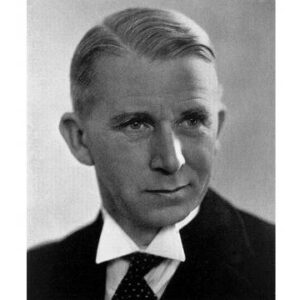Sir Norman Haworth was a British chemist who shared the Nobel Prize in Chemistry with Swiss chemist Paul Karrer in 1937 for their work on carbohydrates and vitamin C. His main area of study was sugars, for which he established the right structures for a number of them, including maltose, lactose, cellulose, starch, and glycogen. His achievements not only added to the field of Organic Chemistry, but also made it possible to produce Vitamin C at a reasonable cost (ascorbic acid). His latter study focused on the better allocation of physical, chemical, and biological challenges involving bacterial polysaccharides. Sir Haworth is well-known among organic chemists for creating the ‘Haworth Projection,’ a two-dimensional representation of three-dimensional sugar compounds. In Bio-Chemistry, this approach is still commonly utilized. In the domain, his book ‘The Constitution of Sugars (1929)’ is a standard text book.
Childhood and Adolescence
Sir Walter Norman Haworth was born on March 19, 1883, in Chorley, Lancashire, England. Walter began working for his father, Thomas Haworth, a linoleum manufacturer, when he was 14 years old.
He had a strong interest in dyes and enrolled to study Chemistry at the University of Manchester, passing the admission exam and enrolling as a student in the Chemistry Department in 1903.
A Career of Norman Haworth
He received a Research Fellowship’ from the ‘Royal Commission of the Exhibition of 1851’ and proceeded on a scholarship to Wallach’s laboratory in Gottingen, Germany for his Ph.D. after graduating with First Class Honors from William Henry Perkin Jr. in 1906.
He finished his Doctorate in 1910 and returned to Manchester in 1911 to receive his D.Sc degree. He completed all of these essential qualifications in the shortest amount of time possible.
Haworth began his career as a senior demonstrator at Imperial College in London in 1911.
He became a Lecturer of Chemistry at St. Andrews University in Scotland in 1912, where he acquired an interest in carbohydrate chemistry.
In 1915, he began working on Simple Sugars and invented ‘Haworth’s Methylation,’ a new method for preparing Methyl Ethers of Sugars using Methyl Sulfate and Alkali.
During World War I, Haworth founded the St. Andrews University laboratory to produce medications and chemicals for the British government.
In 1920, he was named Professor of Chemistry at Durham University’s Armstrong College, and the following year, he was named Director and Head of the department.
He became Professor and Director of the Department of Chemistry at the University of Birmingham in 1925, and he stayed there until his retirement in 1948.
Achievements & Awards
In 1933, Haworth and Sir Edmund Hirst, the assistant director of research, and a group of post-doctoral students deduced the proper structure and optical isometric nature of Vitamin C.
He came up with the moniker Ascorbic acid, which is the common name for Vitamin C. For his ‘Investigations on Carbohydrates and Vitamin C,’ he won the Nobel Prize in Chemistry in 1937. Paul Karrer and he shared the prize.
In 1947, Norman Haworth was knighted.
During 1944-1946, Haworth was President of the ‘Chemical Society,’ and Fellow (1928) and Vice President (1947-1948) of the Royal Society.
The Universities of Belfast, Zurich, and Oslo awarded him honorary Science degrees, as well as an honorary Doctor of Law from the University of Manchester.
Major Projects of Norman Haworth
Sir Haworth contributed to Advances in Carbohydrate Chemistry and produced other scholarly papers. ‘The Constitution of Sugars,’ which he published in 1929, is still used as a basic textbook.
Personal History and Legacy
In 1922, he married Violet Chilton Dobbie, Sir James Johnston Dobbie’s second daughter. They had two boys together.
On his 67th birthday, March 19, 1950, he died of a heart attack. In his honor, the Department of Chemistry at the University of Birmingham was renamed the ‘Haworth Building.
‘ Haworth’s breakthrough in synthesizing Vitamin C and his Nobel Prize were featured on a postage stamp issued by the Royal Mail in 1977 (together with four others).
Estimated Net Worth
Norman is one of the wealthiest chemists and one of the most well-known chemists. Norman Haworth’s net worth is estimated to be $1.5 million, according to Wikipedia, Forbes, and Business Insider.


